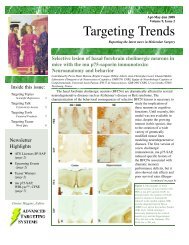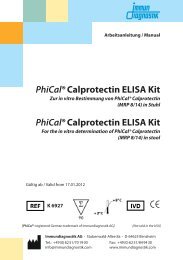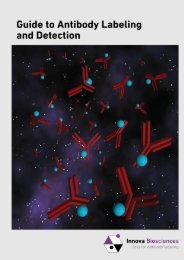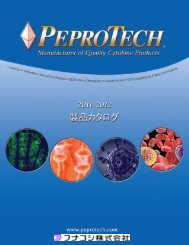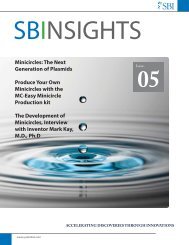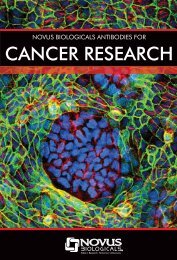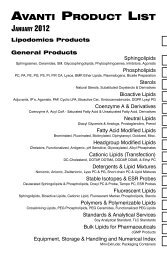Thermo Scientific Pierce Crosslinking Technical Handbook
Thermo Scientific Pierce Crosslinking Technical Handbook
Thermo Scientific Pierce Crosslinking Technical Handbook
Create successful ePaper yourself
Turn your PDF publications into a flip-book with our unique Google optimized e-Paper software.
<strong>Crosslinking</strong> Applications<br />
Protein interactions and associations<br />
Crosslinkers are used for identification of near-neighbor protein<br />
relationships and ligand-receptor interactions. The crosslinkers<br />
chosen for these applications are usually longer than those used<br />
for subunit crosslinking. Homobifunctional, amine-reactive<br />
NHS-esters or imidates and heterobifunctional, amine-reactive,<br />
photoactivatable phenyl azides are the most commonly used<br />
crosslinkers for these applications. Occasionally, a sulfhydryland<br />
amine-reactive crosslinker, such as <strong>Thermo</strong> <strong>Scientific</strong> <strong>Pierce</strong><br />
Sulfo-SMCC (Product # 22322), may be used if one of the two<br />
proteins or molecules is known to contain sulfhydryls. Both<br />
cleavable or noncleavable crosslinkers can be used. Because<br />
the distances between two molecules are not always known,<br />
the optimal length of the spacer arm of the crosslinker may be<br />
determined by the use of a panel of similar crosslinkers with<br />
different lengths. <strong>Thermo</strong> <strong>Scientific</strong> <strong>Pierce</strong> DSS (Product # 21555)<br />
or its cleavable analog DSP (Product # 22585) are among the<br />
shorter crosslinkers used for protein:protein interactions.<br />
NHS-ester, phenyl azides are very useful for this type of<br />
crosslinking because they usually result in efficient crosslinking.<br />
<strong>Thermo</strong> <strong>Scientific</strong> <strong>Pierce</strong> SASD (Product # 27716) is a unique<br />
sulfo-NHS-ester, photoactivatable phenyl azide that is both<br />
iodinatable and cleavable that allows for detection and analysis<br />
of small quantities of protein. For more information on this type of<br />
application for crosslinkers, refer to the free Protein Interaction<br />
<strong>Technical</strong> <strong>Handbook</strong> (Product # 1601672).<br />
Creation of immunotoxins<br />
Specific antibodies can be covalently linked to toxic molecules and<br />
then used to target antigens on cells. Often these antibodies are<br />
specific for tumor-associated antigens. Immunotoxins are brought<br />
into the cell by surface antigens and, once internalized, they<br />
proceed to kill the cell by ribosome inactivation or other means.<br />
The type of crosslinker used to make an immunotoxin can affect<br />
its ability to locate and kill the appropriate cells. For immunotoxins<br />
to be effective, the conjugate must be stable in vivo. In addition,<br />
once the immunotoxin reaches its target, the antibody must be<br />
separable from the toxin to allow the toxin to kill the cell. Thiolcleavable,<br />
disulfide-containing conjugates have been shown to be<br />
more cytotoxic to tumor cells than noncleavable conjugates of ricin<br />
A immunotoxins. Cells are able to break the disulfide bond in the<br />
crosslinker, releasing the toxin within the targeted cell.<br />
Carrier protein conjugation, the creation of immunogens<br />
Many crosslinkers are used for making conjugates for use as<br />
immunogens (Table 2). The best crosslinker to use depends on<br />
the functional groups present on the hapten and the ability of<br />
the hapten-carrier conjugate to function successfully as an<br />
immunogen after its injection. Carbodiimides are good choices<br />
for producing peptide-carrier protein conjugates because both<br />
proteins and peptides usually contain several carboxyls and<br />
primary amines. Carbodiimides such as EDC react with carboxyls<br />
first to yield highly reactive unstable intermediates that can then<br />
couple to primary amines. Often peptides are synthesized with<br />
terminal cysteines to enable attachment to supports or to carrier<br />
proteins using sulfhydryl-/amine-reactive, heterobifunctional<br />
crosslinkers. This method can be very efficient and yield an<br />
immunogen that is capable of eliciting a good response upon<br />
injection. For more information on preparation of immunogen<br />
conjugates, refer to the free Antibody <strong>Technical</strong> <strong>Handbook</strong><br />
(Product # 1601672).<br />
Suggested Reading<br />
For more information concerning accurate measurements of 32<br />
popular crosslinkers using stochastic dynamics calculations, see<br />
the following reference:<br />
Houk, K.N., et al. (2001). Quantitative evaluation of the length of homobifunctional protein<br />
crosslinking reagents used as molecular rulers. Protein Sci. 10, 1293-1304.<br />
Table 2. <strong>Thermo</strong> <strong>Scientific</strong> <strong>Pierce</strong> Crosslinkers commonly used to<br />
produce immunogens.<br />
Crosslinker Reactivity Product #<br />
EDC Amine/Carboxyl 22980, 22981<br />
SMCC Amine/Sulfhydryl 22360<br />
Sulfo-SMCC Amine/Sulfhydryl 22322<br />
MBS Amine/Sulfhydryl 22311<br />
Sulfo-MBS Amine/Sulfhydryl 22312<br />
SMPB Amine/Sulfhydryl 22416<br />
Sulfo-SMPB Amine/Sulfhydryl 22317<br />
GMBS Amine/Sulfhydryl 22309<br />
Sulfo-GMBS Amine/Sulfhydryl 22324<br />
<strong>Thermo</strong> <strong>Scientific</strong> <strong>Pierce</strong> SPDP (Product # 21857) is a reversible<br />
NHS-ester, pyridyl disulfide crosslinker used to conjugate aminecontaining<br />
molecules to sulfhydryls. For several years, this has<br />
been the “workhorse” crosslinker for production of immunotoxins.<br />
The amine-reactive NHS-ester is usually reacted with the antibody<br />
first. In general, toxins do not contain surface sulfhydryls;<br />
therefore, sulfhydryls must be introduced into them by reduction of<br />
disulfides, which is common for procedures involving ricin A chain<br />
and abrin A chain, or through chemical modification reagents. A<br />
second SPDP molecule can be used for this purpose and is reacted<br />
with amines on the immunotoxin, then reduced to yield sulfhydryls.<br />
Another chemical modification reagent that is commonly used<br />
for production of immunotoxins is 2-iminothiolane, also known<br />
as Traut’s Reagent (Product # 26101). Traut’s Reagent reacts with<br />
amines and yields a sulfhydryl when its ring structure opens during<br />
the reaction.<br />
4<br />
For more information, or to download product instructions, visit www.thermo.com/pierce



